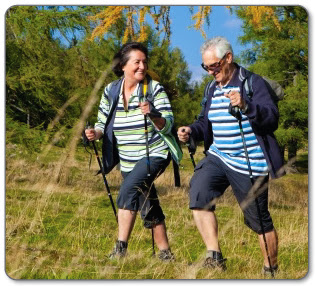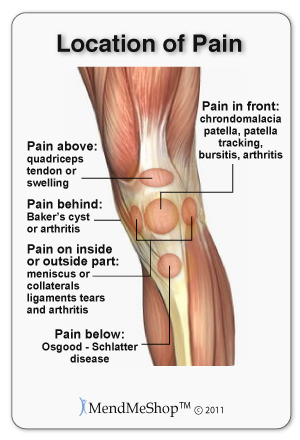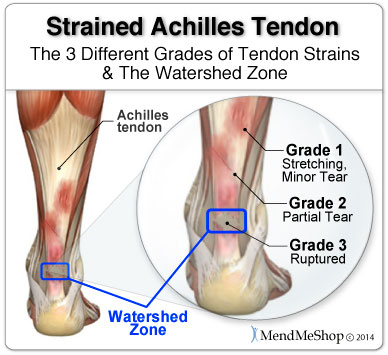
Our bodies use tendons everyday to stretch, pull and move. Tendons are cord-like pieces of soft tissue that connect our muscles to our bones. We have about 400 tendons in our bodies.
Overworking or overloading one area of the body can cause small tears in the tendon. Your body responds by inflaming the tissue to try and heal it, creating a condition known as acute tendinitis. This is your body's way of telling you that you're putting too much stress on your muscle or joint. Your tendon will repair itself quickly if the damage is only slight or is caused by something that may only happen occasionally. If the damage causing your acute tendonitis happens frequently, the pain will continue and the condition may turn into chronic tendonitis.
For some people it may even take weeks or months to get a proper diagnosis and figure out what's causing your pain. For those people, treatment and healing will take even longer because you may spend weeks or months treating an area that's not the true root cause of your symptoms.
If it's now been 3 to 4 weeks with this injury and the pain is still there you could be resting your injury too much, not resting it nearly enough or still waiting for a proper diagnosis on your condition. Even while waiting for a diagnosis, rest is very important for the first few weeks of an acute tendonitis injury. Resting the area and using a Cold Compress or Ice Pack will most likely make a big difference by stopping the damage that's happening to your tendon. Stopping the amount of damage going on in your tendon should be your first priority because it will help to minimize the total amount of time needed to heal.
<Once the swelling is gone, moving the tendon and applying a local circulatory stimulation device like the TShellz Wrap® is really what is needed for completing the recovery cycle. This is critical because tendons are known to receive very little natural blood flow and blood flow is really how your body is able to heal itself. When the tendon tissue is damaged, the already-reduced blood flow is decreased down to a trickle which is why movement is encouraged - it helps get blood flow to where it is needed.
Blood flow (healthy circulation) is an important part of natural tissue healing. Injured tendons take the nutrients available in local blood flow (like oxygen and healing agents) to get rid of any damaged tissue and start growing healthy tissue.
There are many causes of acute tendonitis, some of them include:

Tendonitis can have 3 stages of symptoms:
Stage 1 - Inflammation to the damaged tendon will cause you to have swelling, warmth, redness or a burning pain. You may feel pain and tenderness right outside the affected joint.
Stage 2 - The pain is worse when you move the affected area. Stiffness in the morning or after long-periods of rest or inactivity may also occur.
Stage 3 - At this point people usually experience constant pain. This stage is leading to your condition turning into chronic tendonitis.


Anyone can suffer from acute tendinitis, but it's most common in adults due to degeneration of tissue as we age, over time the tendons will wear down. This is where the fibers in your tendons will become weaker - it's just a natural process that happens as we age.
Acute or sudden tendinitis may become chronic or long-lasting if it isn't treated correctly. We rest for a few days and think once swelling or inflammation (the pain) is gone that the injury is better. We also make the mistake of returning to regular activities too soon without taking the proper time to recover. The truth is that healing takes time and after the swelling is gone your injury is not even close to being fully healed.

In some cases of acute tendonitis, tendon micro-tearing is located in an area known as the watershed zone.
The watershed zone is basically the part of the tendon that has the weakest amount of blood supply (even when it's completely healthy with no tears). This area usually gets blood supply from peripheral veins. This reduced blood supply makes the watershed zone an area of your tendon that's prone to injury and a poor healing response.
Many tendons in the body are known to have watershed zones that are prone to tendon tears. Some of the tendons that have a watershed zone include the achilles tendon, the posterior tibial tendon in the foot / ankle, the rotator cuff (supraspinatus) tendon in your shoulder, the bicep and tricep tendons in your arm and the flexor tendons in your hand - basically these are the tendons that are frequently injured and tough to heal.

We recommend the use of a TShellz Wrap®:
Click HERE to Go To Our Online Store If you have questions, call our office at 1-866-237-9608 (toll free continental US).
The most common question we receive from individuals prior to purchasing is - how many times a day should I be using my wrap and when should I be using them? While treatment plans will differ for each individual and their specific injury, there are general guidelines that should be adhered to.
The TShellz Wrap® would then be used:
We all know that if the injury was healed, the pain would go away but what about the opposite situation? If the pain is gone, does that mean the injury is better? Unfortunately, this is not always true.
Too many people only focus on suppressing pain symptoms while providing less attention to the true healing aspects of the body. Experiencing less pain, while obviously a good short-term goal, does not equate to underlying healing. Scar tissue can remain for months after one gets to a point of being relatively pain-free. However, as long the weak and brittle scar tissue remains, you are susceptible to re-injury or re-aggravation. Certain motions or movements can cause the weaker tissue to easily tear - resulting in some reversal of the recovery up until that point.
This is why we recommend for people to continue with their doctor or therapist recommended exercises and to continue with mild treatments of the TShellz Wrap® for a period of time - to better ensure complete recovery.
Ongoing treatments to enhance circulation are intended to soothe, relax and promote healing of damaged soft tissue in the application area. T•Shellz treatment also results in the ability of soft tissue to extend further due to the effect of heat on soft tissue. The more extensible your tissues are, the less likely they are to strain or sprain.
People tell us all the time, "I was told that if I stay off my feet for a few weeks, my pain will disappear for good."
The truth is, tendonitis pain is usually a culmination of numerous factors, such as repetitive stress, poor posture, acute injuries, and overcompensation issues resulting from other muscle and soft tissue ailments.
It may take weeks or months for these pain triggers to surface. When they , however, merely resting will solve the underlying issues. You need to utilize actions and options that actually treat the source of the pain and help reverse the damage that has been done.
Resting has a role to play, but it is only one small factor in a recovery plan.
Product Advisors are available 9:00 am to 5:00 pm Eastern Standard Time Monday to Friday.
I want to learn more about Post-Surgery Recovery
I want to learn more about TShellz Wrap® Circulatory Boost
I want to learn more about Ice & Heat: Which Is Better For Treatment?
I want to learn more about Tendonitis Treatments
I want to learn more about Tendonitis Surgery
During your recovery, you will probably have to modify and/or eliminate any activities that cause pain or discomfort at the location of your soft tissue injury until the pain and inflammation settle. The more diligent you are with your treatment and rehabilitation, the faster you will see successful results!
Please be aware that this information is neither intended nor implied to be a substitute for professional medical advice. CALL YOUR HEALTHCARE PROVIDER IMMEDIATELY IF YOU THINK YOU MAY HAVE A MEDICAL EMERGENCY. Always seek the advice of your physician or other qualified health provider before using any of our outstanding products to make sure they are right for you and your condition or if you have any questions regarding a medical condition. Always see your doctor for a proper diagnosis as there are often many injuries and conditions (some very serious) that could be the cause of your pain.
© 2025 In.Genu Design Group, Inc. Contact Us